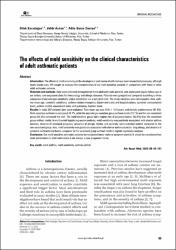| dc.contributor.author | Karadoğan, Dilek | |
| dc.contributor.author | Ayhan, Vehbi | |
| dc.contributor.author | Dursun, Adile Berna | |
| dc.date.accessioned | 2020-12-19T19:35:25Z | |
| dc.date.available | 2020-12-19T19:35:25Z | |
| dc.date.issued | 2020 | |
| dc.identifier.citation | Karadoğan, D., Ayhan, V., & Dursun, A. B. (2020). The effects of mold sensitivity on the clinical characteristics of adult asthmatic patients. Advances in respiratory medicine, 88(2), 99–107. https://doi.org/10.5603/ARM.2020.0083 | en_US |
| dc.identifier.issn | 2451-4934 | |
| dc.identifier.issn | 2543-6031 | |
| dc.identifier.uri | https://doi.org/10.5603/ARM.2020.0083 | |
| dc.identifier.uri | https://hdl.handle.net/11436/1288 | |
| dc.description | WOS: 000531873300002 | en_US |
| dc.description | PubMed: 32383460 | en_US |
| dc.description.abstract | Introduction: the effects of mold sensitivity on the development and course of asthma have been researched previously, although study results vary. We sought to evaluate the characteristics of our mold-sensitive patients in comparison with those of other adult asthmatic patients. Materials and methods: Data were collected retrospectively from adult asthmatic patients who underwent regular follow-ups at our tertiary care outpatient clinic for immunology and allergic diseases. Patients were grouped and compared according to three categories of aeroallergen sensitivity status determined via a skin prick test. the study variables were demographic data, asthma-onset age, comorbid conditions, asthma-related emergency department visits and hospitalizations, systemic corticosteroid burst, asthma control assessment tests, and pulmonary function tests. Results: in total, 242 patients' data were evaluated. Their mean age was 48.6 15.4 years, with female predominance (81.4%). Mold-sensitive asthmatics composed 34.7%, while the aeroallergen-sensitive group without molds (33.1%) and the non-sensitized group (32.2%) composed the rest. the mold-sensitive group had a higher rate of polysensitization (92.8%) than the sensitized group without molds. in multinomial logistic regression analysis, mold sensitivity was positively associated with shorter asthma duration, absence of sinonasal polyposis, presence of allergic rhinitis, and generally well -controlled asthma compared to the non-sensitized group. Also, mold sensitivity was positively associated with shorter asthma duration, drug allergy, and absence of systemic corticosteroid bursts compared to the sensitized group without molds in logistic regression analysis. Conclusion: Our mold-sensitive asthmatic patients demonstrated better asthma symptom control. It should be considered that mold sensitization in adult asthmatics is not always a poor prognostic factor. | en_US |
| dc.language.iso | eng | en_US |
| dc.publisher | Via Medica | en_US |
| dc.rights | info:eu-repo/semantics/openAccess | en_US |
| dc.subject | Adult asthma | en_US |
| dc.subject | Mold sensitivity | en_US |
| dc.subject | Asthma control | en_US |
| dc.title | The effects of mold sensitivity on the clinical characteristics of adult asthmatic patients | en_US |
| dc.type | article | en_US |
| dc.contributor.department | RTEÜ, Tıp Fakültesi, Dahili Tıp Bilimleri Bölümü | en_US |
| dc.contributor.institutionauthor | Karadoğan, Dilek | |
| dc.contributor.institutionauthor | Ayhan, Vehbi | |
| dc.contributor.institutionauthor | Dursun, Adile Berna | |
| dc.identifier.doi | 10.5603/ARM.2020.0083 | |
| dc.identifier.volume | 88 | en_US |
| dc.identifier.issue | 2 | en_US |
| dc.identifier.startpage | 99 | en_US |
| dc.identifier.endpage | 107 | en_US |
| dc.ri.edit | oa | en_US |
| dc.relation.journal | Advances in Respiratory Medicine | en_US |
| dc.relation.publicationcategory | Makale - Uluslararası Hakemli Dergi - Kurum Öğretim Elemanı | en_US |


















